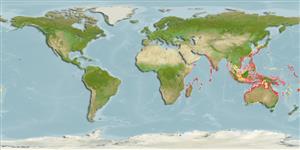>
Acanthuriformes (Surgeonfishes) >
Acanthuridae (Surgeonfishes, tangs, unicornfishes) > Nasinae
Etymology: Naso: Latin, nasus = nose (Ref. 45335).
Eponymy: Captain R W Fagen. We can say no more about him than is contained in James Morrow’s (q.v.) etymology, which states the fish is named after: “…Captain R W Fagen of Miami, Florida, friend and guide on several ichthyological expeditions”. (Ref. 128868), visit book page.
Environment: milieu / climate zone / depth range / distribution range
Ökologie
seewasser riff-verbunden; tiefenbereich 3 - 35 m (Ref. 9710). Tropical
Indo-West Pacific: Kenya south to Bazaruto Islands (Mozambique), Aldabra and Seychelles, and east to the Philippines (Ref. 3145). Reported from southern Japan (Ref. 9710) and Indonesia.
Size / Gewicht / Alter
Maturity: Lm ? range ? - ? cm
Max length : 80.0 cm FL Männchen/unbestimmt; (Ref. 9710)
Rückenflossenstacheln (insgesamt) : 5; Rückenflossenweichstrahlen (insgesamt) : 24 - 26; Afterflossenstacheln: 2; Afterflossenweichstrahlen: 23 - 25. Olivaceous grey in color; adults with small dusky spots and large specimens with a short protuberance above upper lip (Ref. 3145). Body ovate and compressed (Ref. 37429).
An uncommon species found in coral and rocky reefs (Ref. 9710). Solitary or in small groups (Ref. 90102).
Life cycle and mating behavior
Geschlechtsreife | Fortpflanzung | Ablaichen | Eier | Fecundity | Larven
Randall, J.E., 1986. Acanthuridae. p. 811-823. In M.M. Smith and P.C. Heemstra (eds.) Smiths' sea fishes. Springer-Verlag, Berlin. (Ref. 3145)
IUCN Rote Liste Status (Ref. 130435: Version 2024-1)
Bedrohung für Menschen
Harmless
Nutzung durch Menschen
Fischereien: kommerziell
Tools
Zusatzinformationen
Download XML
Internet Quellen
Estimates based on models
Preferred temperature (Ref.
123201): 24.5 - 28.8, mean 27.5 °C (based on 516 cells).
Phylogenetic diversity index (Ref.
82804): PD
50 = 0.5000 [Uniqueness, from 0.5 = low to 2.0 = high].
Bayesian length-weight: a=0.02089 (0.00974 - 0.04480), b=2.96 (2.78 - 3.14), in cm total length, based on LWR estimates for this Genus-body shape (Ref.
93245).
Trophic level (Ref.
69278): 2.2 ±0.1 se; based on size and trophs of closest relatives
Widerstandsfähigkeit (Ref.
120179): niedrig, Verdopplung der Population dauert 4,5 - 14 Jahre. (Preliminary K or Fecundity.).
Fishing Vulnerability (Ref.
59153): High vulnerability (56 of 100).
Nutrients (Ref.
124155): Calcium = 28.8 [16.8, 56.2] mg/100g; Iron = 0.501 [0.251, 0.878] mg/100g; Protein = 18.7 [17.4, 19.8] %; Omega3 = 0.107 [0.064, 0.205] g/100g; Selenium = 38.2 [19.6, 72.1] μg/100g; VitaminA = 43.6 [12.3, 143.3] μg/100g; Zinc = 1.36 [0.93, 1.98] mg/100g (wet weight);
